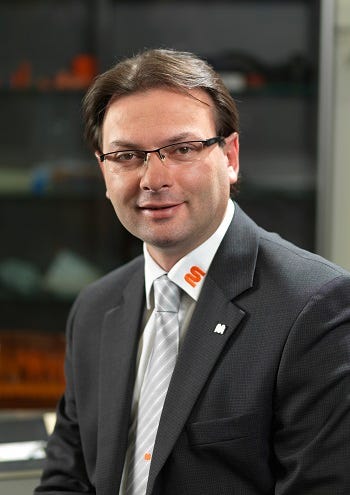Specialist rubber and thermoplastic elastomer (TPE) machine builder Maplan see a bright future for rubber processing and does not view TPEs as a serious threat to its future. This was evident from presentations and discussions at the recent K Show in Germany."We feel TPEs and rubbers complement each other," says Rudolf Eisenhuber, head of the engineering department of Maplan. "TPEs are better when you want a grippy feel but if you want a high class surface finish like in automobile weather strips, then you can't beat EPDM rubber."
November 11, 2013
Specialist rubber and thermoplastic elastomer (TPE) machine builder Maplan see a bright future for rubber processing and does not view TPEs as a serious threat to its future. This was evident from presentations and discussions at the recent K Show in Germany.
"We feel TPEs and rubbers complement each other," says Rudolf Eisenhuber, head of the engineering department of Maplan. "TPEs are better when you want a grippy feel but if you want a high class surface finish like in automobile weather strips, then you can't beat EPDM rubber."
|
Eisenhuber: Thermoset rubbers suited to high temperature engine environments. |
According to Eisenhuber, one might get the impression that TPE will act as a "replacement" for classical elastomers but he says the industry should take a closer look. "TPE has its place in some areas of application, especially where cost aspects are applicable. But in my perception, first and foremost are the growing requirements for rubbers and silicone elastomers, particularly from the automotive sector," says Eisenhuber. "Here the requirement profile increases significantly because higher temperatures come into play. Applications in the engine bay and the exhaust system of modern automobiles are a catalyst. "Downsizing" is the keyword to increase the efficiency of the engines. Increasingly, all components in the engine bay, including those in engine suspension, are exposed to increased thermal stress."
There is also an increased need for chemical resistance. Combustion residues, oil resistance, and resistance to biodiesel are increasingly determining factors," notes Eisenhuber. "We also have not forgotten the desired damping properties, for example in the transmission of vibrations from the engine bay or the drive train which have to be damped. Here, the natural advantages of rubber and silicone materials today have reinforced the effect."
Eisenhuber adds that multi-component and insert molding processes where rubbers are deployed in combination with plastics or metal place high quality requirements on rubber. "This combination is exactly the crux of the matter. Looking at composite parts of elastomers with inserted plastic or metal components or even multi-component solutions, the bar for quality is already high, he says. "High dimensional accuracy and consistent properties of molded parts from different material batches are always the issues in processing, if one has an eye on quality. As the quality demand for rubber molded parts increases, complete documentation is becoming the standard. We try to give our clients who have Cure² Process Optimisation the necessary tool to better control and document the process."
Eisenhuber also notes a global trend for higher degrees of automation. "We notice that there are many inquiries regarding turn-key projects from Asia. Above all, more complete manufacturing facilities are being requested; those with automatic equipping or removal of parts and also optical part verification. This results from qualitative and economic motives and from the attempts towards 'zero-defect production.' New projects from the automotive industry are mostly those with cold runner engineering which saves material. Simultaneously, as the number of the cold runner nozzles rises, the complexity increases."
You May Also Like



